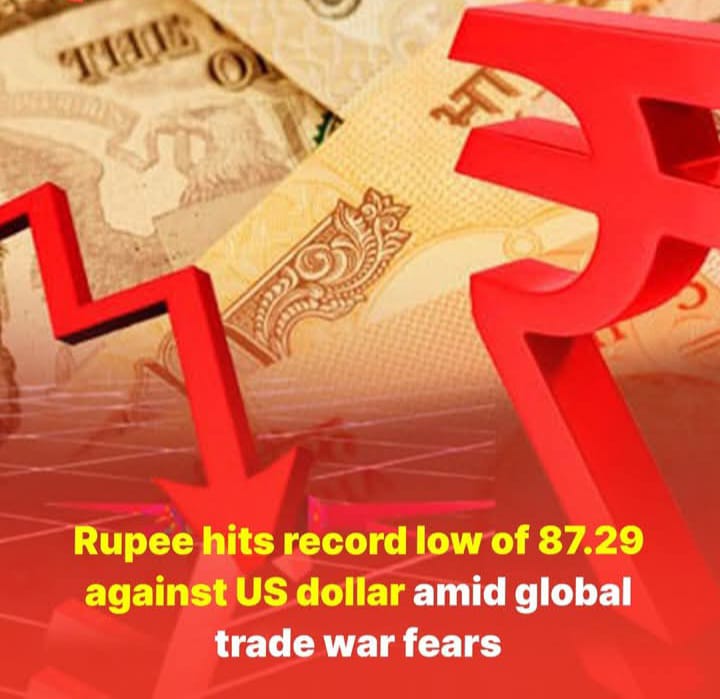The recent news that the rupee hits historic low against dollar has sent shockwaves through the economic landscape.
The Indian rupee has plummeted to an all-time low, breaching the 87-per-dollar mark, a level never seen before in the country’s financial history. This drastic depreciation stems from growing global trade tensions, particularly following recent U.S. tariff hikes on key trading partners such as Canada, Mexico, and China.
Market analysts are particularly concerned as the rupee hits historic low against dollar, fearing further declines may follow.
As these nations prepare countermeasures, market anxieties have intensified, triggering a sharp decline in Asian and European stock markets. The rupee, among the worst-hit currencies, is bearing the brunt of investor fears amid shifting global trade dynamics.
This situation puts the rupee under intense scrutiny as it hits historic low against dollar, affecting perceptions of India’s economic stability.
Experts warn that the currency may continue to face downward pressure, especially as the rupee hits historic low against dollar due to external economic headwinds and shifting U.S. policies.
The global market is reacting sharply to the news that the rupee hits historic low against dollar, influencing investor confidence.
Consequently, businesses are bracing for challenges as the rupee hits historic low against dollar, leading to potential price hikes.
This sharp depreciation brings significant economic challenges, including costlier imports, increased inflation risks, and heightened pressure on India’s fiscal management. Investors and analysts are closely watching for potential government and RBI interventions that could help cushion the rupee’s fall and restore confidence in the currency markets.
Indian Rupee Plunges to Record Low: Impact and Challenges Ahead
The Impact of the Rupee Hitting a Historic Low Against the Dollar
Subheading: Rupee Hits Historic Low Against Dollar: Causes and Consequences
1. Increased Cost of Imports
India relies heavily on imports for crude oil, electronics, machinery, and raw materials. A weaker rupee makes these imports more expensive, leading to higher costs for businesses and consumers.
2. Rise in Fuel Prices and Inflation
Since India imports most of its crude oil, a weaker rupee means fuel prices will rise. This will increase transportation costs, leading to higher prices for essential goods and services, worsening inflation.
3. Higher Cost of Living
Thus, the consequences of the rupee hitting historic low against dollar will ripple across various sectors.
Inflation due to increased import costs will make everyday goods like food, medicine, and electronics more expensive, reducing the purchasing power of common citizens.
4. Expensive Foreign Education and Travel
Indians studying abroad or traveling internationally will need more rupees to exchange for foreign currency, making tuition fees, accommodation, and travel significantly costlier.
5. Rising External Debt Burden
India’s foreign debt, which is denominated in dollars, becomes more expensive to repay, putting additional pressure on the economy and government finances.
6. Weak Investor Confidence
Foreign investors may pull out money from Indian markets due to currency instability, leading to stock market fluctuations and reduced capital inflows. This could slow down business investments and economic growth.
7. Pressure on Small and Medium Businesses
Industries relying on imported raw materials, such as electronics, automobiles, and pharmaceuticals, will see higher production costs, reducing their profitability and competitiveness.
8. Job Losses and Economic Slowdown
As industries struggle with rising costs, many may cut jobs to survive. Sectors like IT, manufacturing, and trade may witness slowdowns, affecting employment opportunities.
9. Weaker Purchasing Power of Salaries
With rising inflation, the salaries of middle-class and lower-income groups may not be sufficient to sustain their lifestyle, leading to financial distress.
10. Uncertainty in the Financial Markets
A depreciating rupee creates volatility in stock and forex markets, affecting investment decisions and economic stability in the long run.
Conclusion, if the rupee continues to decline, India’s economic landscape may face severe challenges. The government and RBI may need to take strategic steps to stabilize the currency and minimize its impact on the common people.
